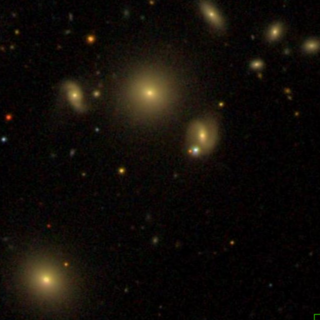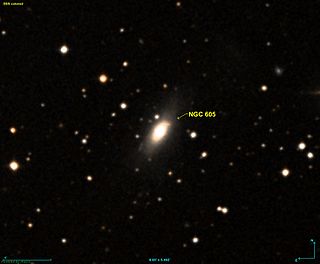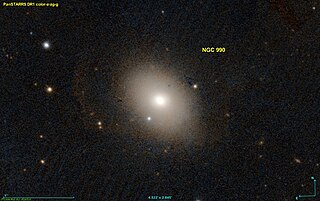
NGC 5755 is a barred spiral galaxy in the constellation Boötes, member of Arp 297 interacting galaxies group of four: NGC 5752, NGC 5753, NGC 5754, and NGC 5755.

NGC 3554 is an elliptical galaxy in the constellation Ursa Major. It was discovered in December 1827 by John Herschel.

NGC 4780 is an intermediate spiral galaxy within the constellation Virgo. It is located about 166 million light-years away from the Sun. It was discovered in 1880 by the astronomer Wilhelm Tempel.

NGC 3281 is a large unbarred spiral galaxy in the southern constellation of Antlia, located at a distance of 144.7 megalight-years from the Milky Way. The galaxy is inclined by an angle of 64° to the line-of-sight from the Earth, with the major axis aligned with a position angle of 137°. It is a luminous infrared galaxy and a type II Seyfert galaxy. NGC 3281 is a member of the Antlia Cluster, which belongs to the Hydra–Centaurus Supercluster.

NGC 1728 is a spiral galaxy in the constellation Eridanus. The galaxy is listed in the New General Catalogue. It was discovered on November 10, 1885 by the astronomer Edward Emerson Barnard.

NGC 159 is a barred lenticular galaxy in the constellation Phoenix. The galaxy was discovered on October 28, 1834, by John Frederick William Herschel.

NGC 1683 is a spiral galaxy in the constellation Orion. The object was discovered in 1850 by the Irish astronomer William Parsons.

NGC 1326 is a lenticular galaxy in the constellation Fornax, 63 million light-years away. It was discovered by English astronomer John Herschel on 29 November 1837. It is a member of the Fornax Cluster, an NGC 1316 subgroup and has a diameter of 70 000 light-years.

NGC 834 is a spiral galaxy located in the Andromeda constellation. It is estimated to be 160 million light-years away from the Milky Way galaxy and has a diameter of about 65,000 light-years. The object was discovered on September 21, 1786 by the astronomer William Herschel.

NGC 740 is a barred spiral galaxy located in the Triangulum constellation. It is estimated to be 210 million light-years from the Milky Way and has a diameter of about 85,000 light-years. It was discovered by the Irish engineer Bindon Stoney, an assistant to William Parsons.

NGC 605 is a lenticular galaxy in the constellation Andromeda, which is about 234 million light-years from the Milky Way. It was discovered on October 21, 1881 by the French astronomer Édouard Jean-Marie Stephan.

NGC 690 is an intermediate spiral galaxy located in the constellation Cetus about 236 million light-years from the Milky Way. It was discovered by the American astronomer Francis Leavenworth in 1885.

NGC 701 is a spiral galaxy with a high star formation rate in the constellation Cetus. It is estimated to be 86 million light years from the Milky Way and has a diameter of approximately 65,000 light years. The object was discovered on January 10, 1785 by the German-British astronomer William Herschel.

NGC 990 is an elliptical galaxy located in the constellation Aries about 153 million light-years from the Milky Way. It was discovered by the German - British astronomer William Herschel in 1786.

NGC 904 is an elliptical galaxy in the constellation Aries. It is estimated to be 244 million light years from the Milky Way and has a diameter of approximately 85,000 ly. NGC 904 was discovered on 13 December 1884 by the astronomer Edouard Stephan.

NGC 906 is a barred spiral galaxy in the constellation Andromeda in the northern sky. It is estimated to be 215 million light years from the Milky Way and has a diameter of approximately 110,000 ly. NGC 906 was discovered on October 30, 1878 by astronomer Édouard Stephan.

NGC 804 is a lenticular galaxy located in the Triangulum constellation about 231 million light-years from the Milky Way. It was discovered by the American astronomer Lewis Swift in 1885. This galaxy was also observed by the French astronomer Guillaume Bigourdan on December 24, 1897, and it has been added to the Index Catalogue under the symbol IC 1773.

NGC 996 is an elliptical galaxy of the Hubble type E0 in the constellation Andromeda. It is estimated to be 210 million light years from the Milky Way and has a diameter of approximately 75,000 ly. The supernova SN 1996bq occurred in this galaxy. NGC 996 was discovered on December 7, 1871 by astronomer Édouard Stephan.

NGC 531 is a barred spiral galaxy in the constellation Andromeda with a visual magnitude of 10.51. It is a distance of 65.7 Mpc from the Sun. It is a member of the Hickson Compact Group HCG 10, and is interacting with the other members of the group.

NGC 861 is a spiral galaxy in the constellation Triangulum. It is estimated to be 360 million light-years from the Milky Way and has a diameter of approximately 165,000 light-years. The object was discovered on September 18, 1865 by Heinrich d'Arrest.




















